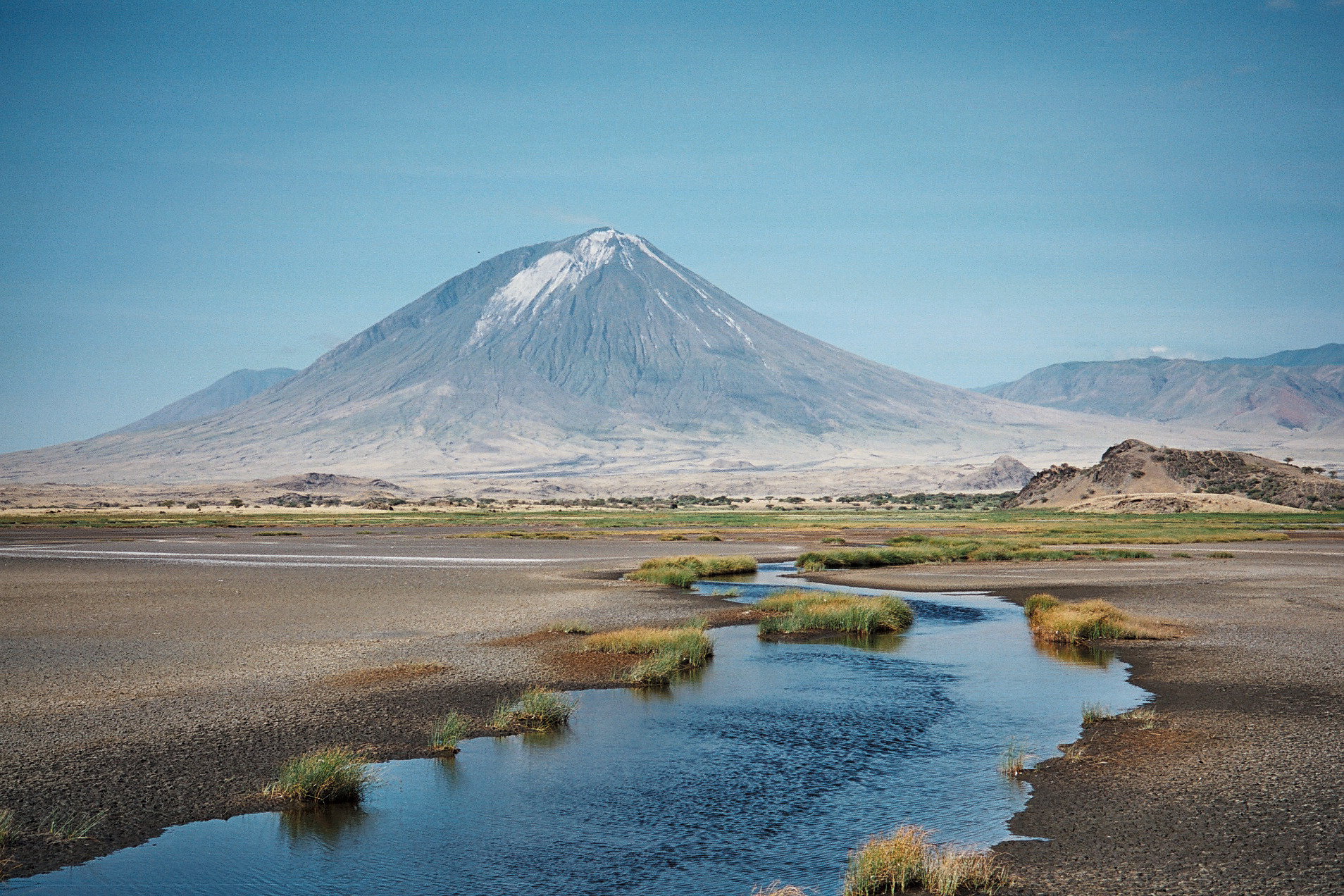Lake Natron: Everything You Need to Know

If you search for Lake Natron, Google will show you some haunting pictures of mummified birds and ruby-red waters. Seems like a scene straight out of a Stephen King novel. But what’s the big deal? Why such spooky pictures of a lake?
Lake Natron is one of the most famous lakes in the Northern circuit and situated close to an active volcano, Ol Doinyo Lengai known for its thin silvery lava. The minerals, such as salt, soda, and magnesite, from the volcano, have turned Natron into an incredibly alkaline water body which has also made it deadly for many creatures. So as the birds and animals die near the lake, the high content of salt calcifies their dead bodies turning them into stones. There is no paranormal activity going on here, it is just natural minerals.
Because the lake is encrusted with so much salt, Spirulina, a species of blue-green algae that absolutely loves salt, started growing here. The algae have a red pigment which in turn makes a huge part of the lake seem red. Although, it is not red at all times. The colour deepens and fades.
So Lake Natron offers a completely different landscape to the rest of the safari locations in the northern circuit. Quite a few find the looming silhouette of Ol Doinyo Lengai in the background of the wide open plains of the lake, a spectacular scenery. So read on to see if Lake Natron is for you.
Contents
Wildlife
More than wildlife, Lake Natron is more for the people who are interested in stunning sceneries and landscapes that differ from the rest of the safari. So while Lake Natron does not exactly have open grasslands and woodlands that would be preferred by the animals, some do live in the vicinity. The region has tufts of grass and water pools that are not as toxic and so attract some animals. You might be able to spot herbivores like gazelles, giraffes, zebras, lesser kudus, and maybe even dromedary camels. And you might also get the chance to spot smaller carnivores like golden jackals.
Birds
Lake Natron is most famous for the flamingoes that it attracts. These birds do not find the lake toxic like many other creatures, and in fact they feed on the algae that are present in this lake. And this very algae gives them their distinctive red colour. If you go during the months of September and October, you might be able to catch thousands of flamingos breeding in this region.
But Natron attracts various other birds besides the Flamingos. Marabou Storks arrive here in huge numbers as well. And besides Marabou, you should also be able to spot Ostriches, Kori Bustards, Secretary Birds, and Vultures.

Things to Do
Lake Natron is one for the adventurers. One of the most popular activities to do at Lake Natron besides bird watching is going for a hike on the mighty Ol Doinyo Lengai. Ol Doinyo Lengai is the third-highest peak in Tanzania, and a hike can take up to 12 hours! You will be guided up the mountain by a Maasai man and attempt to get to the very summit. Keep in mind that the volcano gets quite steep at the top and it can be very difficult to get to the rim. The region is quite slippery and rocky. To add to that, because of the lava swirling below, the mountain also gets hot. Reaching the rim, however, is a rewarding experience. You can see the gasses coming out of the volcano, and look out at the wide hazy expanse below you. It’s truly a mesmerising view.
Another place for going up for a hike in the region is the Ngare Sero Waterfall. The trail leading to the waterfall is not very tricky to navigate, though at times as it can get narrow and steep, and some regions might be filled with some water so your shoes and the bottoms of your trousers are bound to get drenched. However, similar to Ol Doinyo Lengai, the hike will be rewarding. The pool at the base of the waterfall is like an oasis in the midst of a desert. After a tough, sweaty hike you can cool down by going for a swim in the pool, walk under the waterfall and have a picnic on the rocks nearby.
Both the hikes are rewarding but they can get tricky and difficult. You must only choose to go for them if you are sure you are fit enough.
You will also be meeting a lot of Maasai people while roaming around in the region, you can visit their Bomas as well. You may engage in conversation with the tribesmen with the help of your guide and take part in their everyday activities. You are also likely to find the Maasai experience near Lake Natron much more authentic than the Maasai village experience in other popular places such as Ngorongoro. To get more details about Maasai village tours, click here.
Lake Natron is also a place of importance for enjoyers of ancient history. Engare Sero to the south of the lake is a time machine that will take you back 19,000 years. The region has some really well-preserved footprints of early hominids. The flow of debris from the volcano buried the footprints and this protected them for thousands of years. These footprints are really exciting for scientists and history enthusiasts as they give an insight into what the lives of Homo sapiens must have been like ages ago.
Weather and Climate
Lake Natron is in an arid region which means the temperature around here can get quite high. At day time the temperature is around 30° C and can even go above 40°C / 104°F past 2 P.M.
The lake’s temperature can itself go as high as 60°C / 140°F because of the chemical mixtures in it!
When to Visit
Tanzania experiences a dry season from July to October which would also be good months to visit Lake Natron. Because of no rain, the region will be less humid and cooler
If you want to get a view of the flamingos and other birds then mostly August to October are your months. To get confirmation about whether you will be able to see the flamingos or not while visiting you should get in touch with your tour operator.
Accommodations
Section to be updated.
Location and How to Reach
Lake Natron is located in Northern Tanzania and is North East to the Ngorongoro Conservation Area.
You can travel to Lake Natron by road. From the city of Arusha, it will take about two and a half to three hours to reach Lake Natron. Or, you may drive to Lake Natron while you are on your way back from Serengeti or Ngorongoro.
Fees
Section to be updated.
Safari Tours
We offer various itineraries that include safari tours to Lake Natron. To view some of our popular tours, click here.
FAQs
How many days do we recommend spending here?
We recommend a minimum of two days at Lake Natron. During the two days, you can visit the lake, look out for birds, meet the Maasai, and visit the base of Ol Doinyo Lengai. If you are interested in hiking then you might want to spend a couple of extra days.
Which place is better for hiking?
Ol Doinyo Lengai and Ngare Sero Waterfall, both are rewarding in their ways.
Ol Doinyo is the third highest peak in Tanzania, and the hike will take about 6-12 hours. The hike is quite difficult as it is rocky, slippery, hot, and quite steep. The summit however will be cold so it is recommended that you carry warm clothes. The view from the top will be magnificent, however. If you’re in for the adventure then you must surely go for it.
The Ngare Sero hike is easier. It will take about two hours and the trail is quite basic. But some regions will be filled with water so you must dress accordingly. At the end of the trail, you will be able to take a dip in the pool at the base of the waterfall. There will be plenty of rocks and palm trees to provide you with shade.
So it depends on what suits you more.
Will the Lake be red when I visit it?
The redness of the lake is not a fixed colour. It appears red when the algae in it bloom. While the algae are declining the lake might instead appear in different shades of orange. And at other times it might not seem red or orange at all.
While you are there you can always ask your guides to take you to the region where the lake might appear reddish.
Will I be able to spot the Flamingos?
You should be able to spot the Flamingos from August to October. Before going please check with your tour operator whether the Flamingos have arrived in the region or not.
